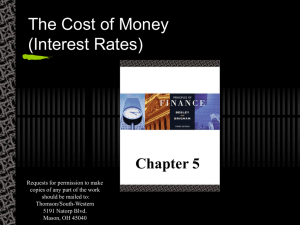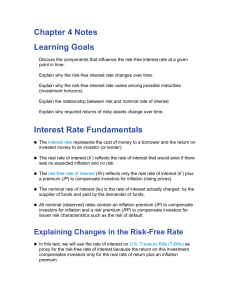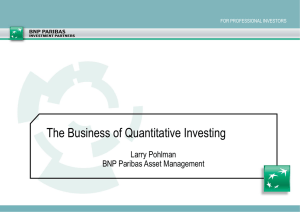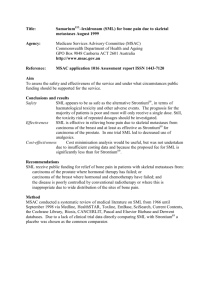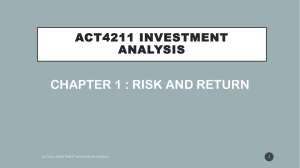Above average market risk
advertisement
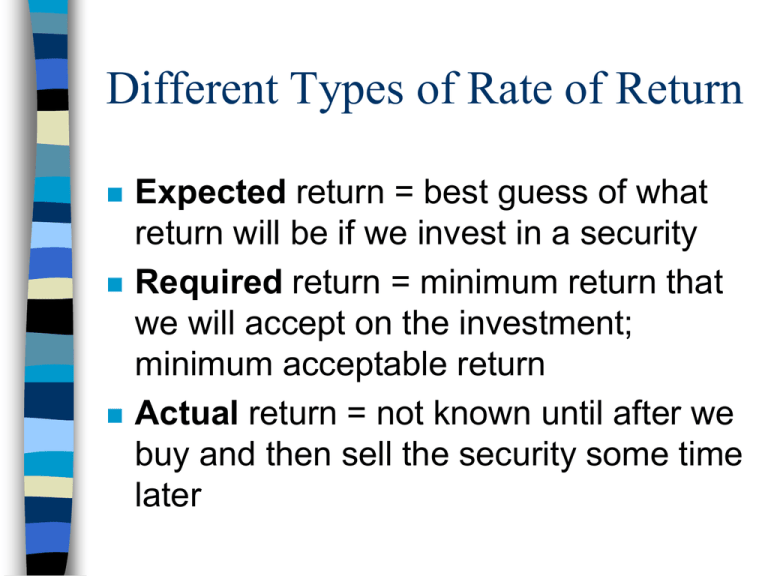
Different Types of Rate of Return Expected return = best guess of what return will be if we invest in a security Required return = minimum return that we will accept on the investment; minimum acceptable return Actual return = not known until after we buy and then sell the security some time later Using Expected vs Required to Make Investment Decisions If expected return > required return, BUY If expected return < required return, SELL If expected return = required return, HOLD (stock is in equilibrium) Capital Asset Pricing Model Model that relates risk to rate of return Tells investors how much they should require as a rate of return, given a stock’s level of market risk (Remember, no reward for bearing company-specific risk. Investors should diversify!) Kc = Rf + (Km - Rf) Kc= Common stockholders’ required rate of return Rf = Risk-free rate of return Km = Expected return on portfolio of all stocks; expected return on the stock market = Beta, measure of market risk Risk-free Rate of Return Rf has two components: 1) A true, or real, rate of return that would be earned in a perfect world 2) An inflation premium (points to cover investors for rate of inflation) Rf can be estimated using return on T bills Market Rate of Return Km is an estimate of what investing in the whole stock market would provide as a rate of return Estimate Km by looking at predictions for market index like S&P 500 Difficult to forecast; easier to evaluate using past data (Km - Rf) = Market Risk Premium Difference between return on whole market and risk-free rate of return Extra reward (points) to investors for exposure to average market risk Size of market risk premium reflects investors’ degree of risk aversion (how investors feel about investing in the stock market – safe or scared?) (Km - Rf) Market risk premium tailored for how much market risk a given company has Average market risk ( = 1.0): Required return = Market return Km Above average market risk ( > 1.0): Required return > Market return Km Below average market risk ( < 1.0): Required return < Market return Km Graphing CAPM X axis = (Market Risk) Y axis = Kc (Required Rate of Return) Relationship is linear - just need two points to graph CAPM: – 1) If = 0, Kc = Rf – 2) If = 1.0, Kc = Km Security Market Line (SML) Graphically shows relationship between market risk and required rate of return Locate firm on X axis using its beta Go up to intersection with SML and over to Y axis to see firm’s required rate of return Slope of SML Slope of SML: – Rise/Run – (Y1 - Y0)/(X1 - X0) – Change in Kc/Change in – Market risk premium (Km - Rf) What Slope of SML indicates: The slope of the SML reflects investors’ degree of Risk Aversion When slope is steep (high market risk premium, high required rates of return), this indicates that investors are nervous (worried, concerned) about investing in the stock market and want higher returns on every stock. When slope of SML is flatter (lower market risk premium, lower required rates of return for every stock), this reflects that investors are more comfortable investing in the stock market and don’t perceive market risk as being such a danger. Changes in slope reflect changes in investors’ perceptions about market SML and Changes in Inflation When inflation changes, the risk-free rate of return changes (inflation is one of its components) Y intercept changes Slope remains constant (assuming investors’ perceptions about market risk are unchanged), so Km must also change to preserve constant slope! Changes in Inflation When Rf increases, Kc increases by the same amount Higher inflation leads to higher required rates of return for all stocks When Rf decreases, Kc decreases by the same amount Lower inflation leads to lower required rates of return for all stocks Relationship of Inflation and Stock Prices When inflation is high, stock prices are NOT high Required rates of return on stocks are high to cover for increase in inflation Higher required returns lead to lower stock prices When inflation is high, stock prices are LOW! (And vice versa.)

